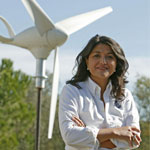 In just a few weeks Copenhagen will be a hive of wind energy activity as EWEA’s annual conference and exhibition gets going. In the run-up to the event, the EWEA blog spoke to Ana Estanqueiro, Chair of a session aimed at discovering how to integrate large amounts of wind power into Europe’s grids…
In just a few weeks Copenhagen will be a hive of wind energy activity as EWEA’s annual conference and exhibition gets going. In the run-up to the event, the EWEA blog spoke to Ana Estanqueiro, Chair of a session aimed at discovering how to integrate large amounts of wind power into Europe’s grids…
What are the main obstacles in Europe to integrating large amounts of wind power?
The main barriers these days are much less on the “hardware” side (access to transmission and distribution grids) and much more on the “software” side: grid-operation principles and electricity market rules. These are currently not well adapted to wind power and need to evolve in order to smoothly incorporate wind-powered electricity. Today, difficulties related to grid access are largely for offshore projects where investments are extremely high and usually need to be coordinated with other economic sectors.
 In just under one month, Copenhagen will be home to Europe’s biggest wind energy conference and exhibition – EWEA 2012. The EWEA blog caught up with Emmanuelle Raoult, Chair of a session which delves into Europe’s progress on meeting the 20% renewable energy by 2020 target, to find out the current state of play…
In just under one month, Copenhagen will be home to Europe’s biggest wind energy conference and exhibition – EWEA 2012. The EWEA blog caught up with Emmanuelle Raoult, Chair of a session which delves into Europe’s progress on meeting the 20% renewable energy by 2020 target, to find out the current state of play…
What are National Renewable Energy Action Plans (NREAPs) and why are they important?
NREAPs are detailed roadmaps of how each EU Member State expects to reach its legally binding 2020 targets. These are essential for Europe’s energy future, and can deliver the strong and stable regulatory framework that is needed to develop renewable energy in Europe. Furthermore, NREAPs give the renewables industry ‘business case certainty’ – a key driver to attract investment in renewable energy. As wind energy projects are 20+ year investments, decreasing the risk of regulatory volatility is paramount to achieving an acceptable return on investment. NREAPs – if properly implemented – help reduce uncertainty.
 In just a few weeks Copenhagen will be a hive of wind energy activity as EWEA’s annual conference and exhibition gets going. In the run-up to the event, the EWEA blog spoke to Ana Estanqueiro, Chair of a session aimed at discovering how to integrate large amounts of wind power into Europe’s grids…
In just a few weeks Copenhagen will be a hive of wind energy activity as EWEA’s annual conference and exhibition gets going. In the run-up to the event, the EWEA blog spoke to Ana Estanqueiro, Chair of a session aimed at discovering how to integrate large amounts of wind power into Europe’s grids…






 Comments
Comments
